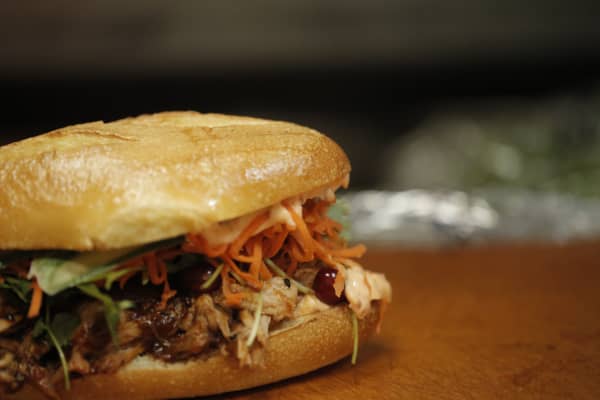Ratha Chaupoly and Ben Daitz met at Clark University in 1992. After graduation, Daitz worked in some of the finest kitchens in the country, including Bouley, Daniel, Le Cirque and Tabla. A hiatus from the kitchen landed Daitz at a private equity firm, where he delved in to the real estate side of the restaurant industry. After graduation, Chaupoly spent time in Maine exporting sea urchin to Japan, before landing positions at restaurants such as The Elephant Walk, Blue Water Grill and Fleur de Sel. He then opened his own restaurant, Kampuchea, in New York City's Lower East Side, where his Cambodian sandwiches were a hit. With their eye on the customer craze for the sandwiches, the pair decided to open the Num Pang sandwich shop in March 2009. Six years, eight shops and several partnerships later (they've collaborated on sandwiches with Ad-Rock, Mario Batali, Jean-Georges and more), Zagat ranked Num Pang the No. 1 fast casual in New York. Here's how Daitz and Chaupoly built their sandwich empire.
When crowds extended all the way down the block to order our sandwiches at our first shop, we knew Num Pang had legs. Fast-forward six years, we have shops all over New York City in Union Square, Times Square, Grand Central, NoMad, Chelsea Market, Battery Park City, South FiDi, and North FiDi. We put a ton of hard work and focus into every aspect of the business to ensure the quality and integrity remains intact as we grow.
Here are five tips for successfully launching and expanding a retail business in any sector:
1. Perfect your product
The sandwich is key. We knew we had a good product when the Cambodian sandwiches were flying out the door at Kampuchea (the Cambodian restaurant that Ratha opened in 2009). We put all of our energy into making those sandwiches the best they could be, from the toast level on the bread and the creative fillings to the perfect ratio of chili mayo, cucumbers, pickled carrots and cilantro.
We knew if we kept up the quality of the sandwiches and gave them a home of their own, they could really shine. Before starting any business, it's essential to understand and perfect your product. Test it out with friends, family and strangers. Do your research, and test it out in the marketplace. Once you're confident in your product, others will likely be, too. If you are looking to build outside capital from the start, this becomes even more essential — an established product with a proven market is key to getting investor attention, no matter what the business.
2. Understand how real estate impacts your business
New York City real estate landed us in a tiny space in Union Square. It was essential that we didn't bite off more than we could chew (no pun intended) so we developed a hyperfocused menu of six to eight sandwiches. The shop had a tiny, 150-foot kitchen and very little storage, so our operation was lean and scrappy. That meant giving that space as much authentic character as we could and pushing our limits to meet demand. We blared hip-hop from the speakers, covered the walls in graffiti murals (that would become our signature aesthetic across all of the shops), and schlepped pork from our personal home kitchens to compensate for the lack of space. Before we knew it, we were selling 400-500 sandwiches a day.
As we expanded into bigger spaces, we also expanded the menu. Real estate determines much more about a retail concept than many people realize. You can have your product perfected, but it's not until you find a home for it, that you can really plan how you'll execute.
3. Define your core values and stick to them
As we expanded, it was essential that our core values were crystal clear — not only to us but to everyone at the company. For us, that's putting both the product and guest experience first. We want all of our team members to take pride in the work that they do and always ask them the question, "Would you eat this yourself?" But before we do that, it was on us to create a system to push the same messages across all locations and resources for staff that sets them up for success. Maintaining consistency across a growing company, no matter the industry, is everything.
4. Stay flexible and know your limitations
Though it may seem counterintuitive, the first step to conquering consistency is staying flexible. In our industry there are several methods to controlling flavor. Companies build commissaries, outsource products, create in-house recipe systems, you name it. The key is keeping your "method" flexible without compromising quality. When you are growing a business, you are going to hit several learning curves. It's vital to have the flexibility and open-mindedness to realize that what worked in one location simply cannot work in two, what works in two cannot work in three, and so on. When you hit your learning curve, seek help from people that can help you overcome it — and be open to re-jiggering the system.
Realize your limitations and make strategic hires with people who have complementary skills. The term "value add" is commonly used with investors. Do your homework and talk to people you trust about what that means and which areas you need value added, from operations to marketing.
5. Remember why you started
There are several common pitfalls that come along with scaling a business. One of the most common is expanding faster than your infrastructure. To grow responsibly and successfully, continually evaluate internal infrastructure and operations to identify staffing and system needs. Remember why you started. For us, it was to serve the best Cambodian sandwiches possible. As long as that goal continues to be realized, the sky is the limit.




